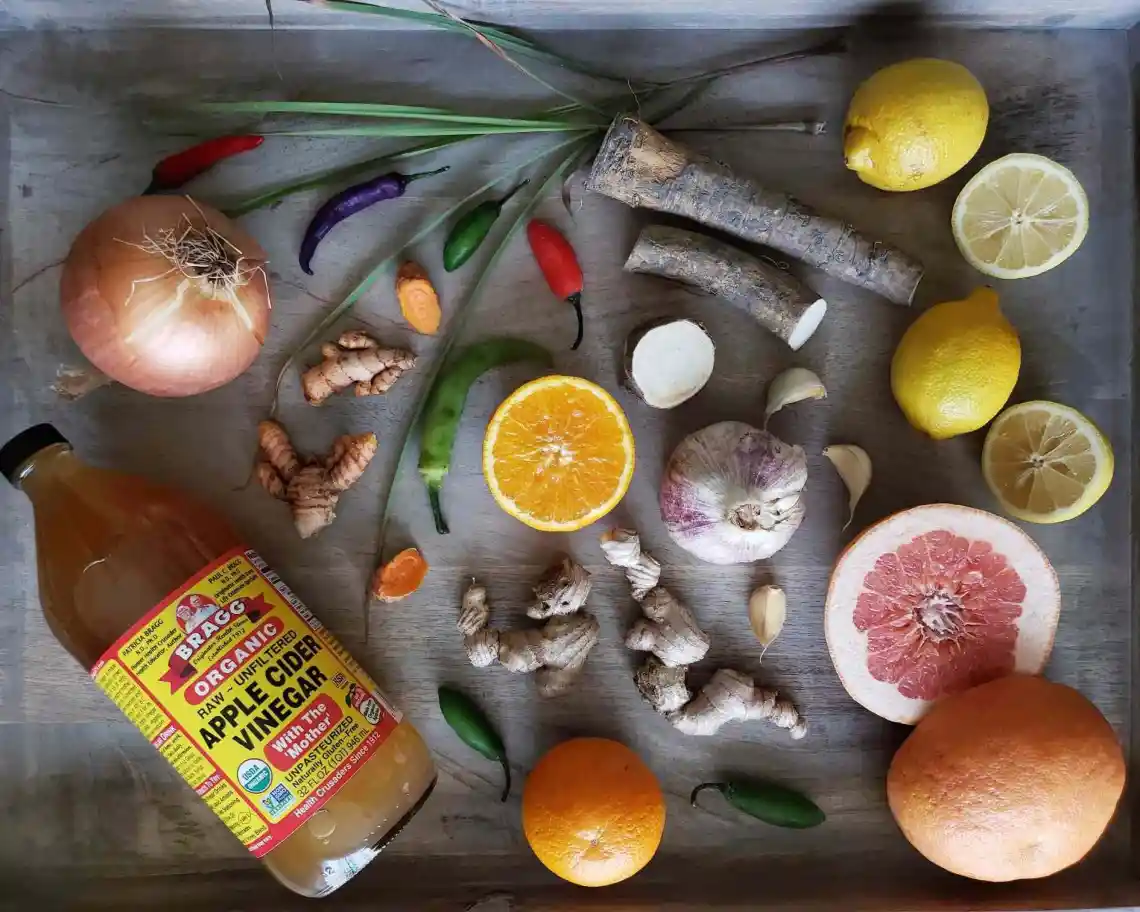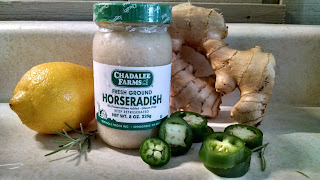
Sustaining Winter Wellness With Fire Cider
As we move into the cooler months of the year, I like to turn to a few favorite remedies to keep my immune system healthy. I stay hydrated, enjoy lots of hearty soups, and am sure to head to the woods often to enjoy the changing of the seasons-- and this year, I’ve begun making fire cider!
Fire cider is a fun little potion of infused apple cider vinegar. It offers an intensely sweet, spicy, tangy flavor from ingredients like jalapeno, garlic, onion, turmeric, ginger, honey, and a variety of herbs and spices. These super healthy ingredients, when infused in apple cider vinegar, can not only boost the immune system but also aid in digestion, sinus clearing, and in providing lots of natural energy-- plus, it’s just really tasty. Fire cider is incredible for the immune system when taken directly by the spoonful like a “shot” each morning, but it can also be used as a sort of sauce or marinade in recipes like fried rice, winter soups, or homemade salad dressing. There are so many ways to enjoy this fascinating beverage, but first we have to make it!

Fire cider is not a fermented beverage -- that is, it is not alcoholic or fizzy. Rather, it’s an infusion, which means that to make fire cider we are essentially soaking some chopped vegetables and spices in vinegar for a few weeks to allow the great flavors and health benefits of our ingredients to soak into the vinegar. There is no scary airlock system and no risk of building air pressure in your brew jar. However, if you ever notice any kind of fizziness, mold, or weird discoloration, smell, or taste in your fire cider, be sure to throw out your batch and start again. Also keep in mind that apple cider vinegar, infused or not, is not for everyone. Be sure to pay attention to recommended doses and be aware that apple cider vinegar can irritate stomach ulcers, and is not recommended to those who have stomach ulcers. Also, some folks find that apple cider vinegar contributes to, rather than improves, indigestion. To help with this, consider diluting the vinegar, adding maple syrup or honey to it, or discontinuing the use of apple cider vinegar altogether.
To infuse our apple cider vinegar, we will need a glass quart jar and a plastic lid. First, we chop a variety of vegetables (or use a food processor to dice them all quickly) and add them to our quart jar. One ingredient that may be hard to find at local grocery stores is fresh horseradish root-- if you’re unable to find it, don’t substitute it with any kind of horseradish cream sauce, which might cause your fire cider to mold. Instead, use a jar of diced horseradish that doesn't include any additive ingredients like sauce or flavorings. If there are other ingredients that you’re unable to find, either substitute it to the best of your ability without allowing additives into your brew, or omit it entirely -- whichever causes less stress for you! Remember that making fire cider is supposed to be fun!

After making my first batch of fire cider with horseradish from a jar, I found some fresh horseradish root at Hartland Meijer in the produce section. I peeled it and grated it with a cheese grater for my second batch of fire cider, stopping every once in a while to make cleaner cuts on the root to make the grating easier. As I was grating my GIANT peeled horseradish root, a tiny piece of horseradish shot into my nose. So let’s just say that it was an intensely sinus-opening experience.... but well worth it.
Next, we add our spices and herbs to the jar -- wonderful ingredients like cayenne pepper, rosemary, and turmeric. Then, we pour apple cider vinegar over the veggies and herbs until the vinegar reaches the top of the jar. Shake the jar well, store it somewhere dark and cool (I stored mine in a paper bag in a closet) for about four weeks, and wait. Honestly, preparing the fire cider wasn’t too difficult-- the hardest part of the process is remembering to shake the jar every day for a month! I started making it a part of my daily routine to shake the fire cider jar while I was waiting for my morning coffee to brew.
After three weeks of shaking the jar every day and waiting, I couldn’t help myself-- I tasted my brew! The fire cider is tart from the apple cider vinegar, but also packs a punch with the spicy jalapeno, cayenne, and aromatic garlic. I noticed that the herbs, like rosemary, really helped to round out the flavor as well. The fire cider can be ready after three weeks, but it’s best to wait about a month so that the flavors can really meld together.
After four weeks of infusing, the fire cider is ready. The next steps are to use cheesecloth or a fine strainer to strain out the veggies (pulp) from the liquid (your fire cider!). Remember not to discard this veggie pulp, because it can be sautéed with other veggies as a stir-fry or added to your other favorite dishes for an extra boost of flavor. Next, add honey to taste to the fire cider-- typically recipes call for about ¼ cup of honey, but you can adjust to your preference or leave it out altogether if you don’t want your spicy concoction cut with any sweetness.
I gently warmed 1/4 cup of honey that had crystallized slightly, and added that to my fire cider. I enjoyed the slight sweetness of it with the spicy, tangy cider. After that I put my pulp in a labeled jar for later use in some yummy recipes, and put my beautiful fire cider into a few jars to get me through these next chilly weeks.
I had so much fun making my fire cider. It’s a really fun way to mark our seasonal shift into the late stages of fall: plus, keep in mind that some folks enjoy bringing out a fresh batch of fire cider during great harvest feasts, so this may be the perfect time to get brewin’ for a Thanksgiving batch! The recipe I used to make my first batch of fire cider is a pretty basic one, but there is a huge variety of other fire cider recipes out there-- you can mix up the herbs used in your recipe depending on your preferences or what you have on hand, and more honey can be added for desired sweetness if you want to cut the tartness a little. For a plethora of recipe variations and other fun info on fire cider, I recommend checking out a book called Fire cider! 101 Zesty Recipes for Health-Boosting Remedies Made With Apple Cider Vinegar by Rosemary Gladstar. This fun, informative book offers fire cider recipes from around the world, as well as the many ways we can use apple cider vinegar and fire cider salad dressings, sauces, meat dishes, veggies, and more. There are fun stories, poems, and beautiful artwork in this fantastic book as well-- be sure to give it a look!

Another helpful resource for learning more about fire cider is a website called Mountain Rose Herbs. Much of what I’ve learned about fire cider, along with the recipe that I used for my very first batch, can be found here. This website also shares some interesting context on fire cider, such as the recent legal battle surrounding the trademarking of traditional herbal products.
And remember, if you aren’t able to make a batch of fire cider yourself, you can always give it a try from a local health store or vitamin shop, or order it online!
Now more than ever, we are realizing the importance of our immunity and keeping ourselves healthy -- so what better way to sustain our health than with a combination of some of the best immune system supporting foods available to us? Fire cider is a fun, tasty, and incredibly healthy way to pay homage to a productive growing season and transition to the cooler months of our year. Give fire cider a try this fall, whether you find it in a local shop or make a batch of your own!